Is Taste Sensitivity Declining? Is Umami Desensitization on the Rise?
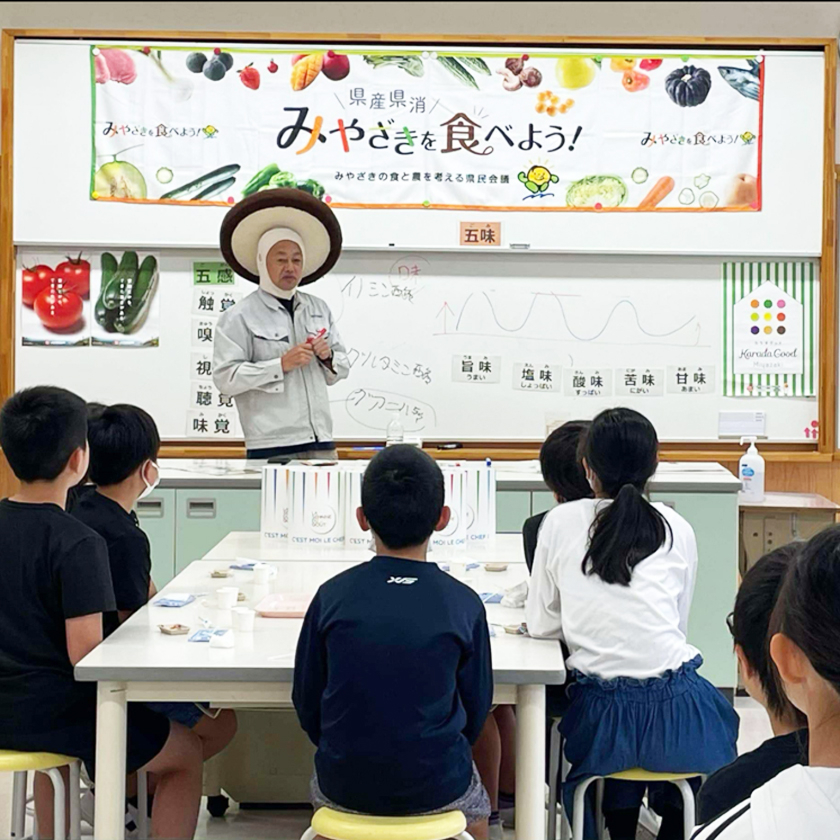
Tag: #Umami Sensitivity #Natural Dashi #Japanese Cuisine #Taste Education #Healthy Eating
Table of Contents
In this article, we’ll explain:
✅ Many academic papers are raising concerns about the decline in taste sensitivity among young people.
✅ The impact of becoming less sensitive to "umami" (umami desensitization).
✅ Simple steps you can take to improve your taste sensitivity.
1. Young People's Taste Sensitivity Is Declining
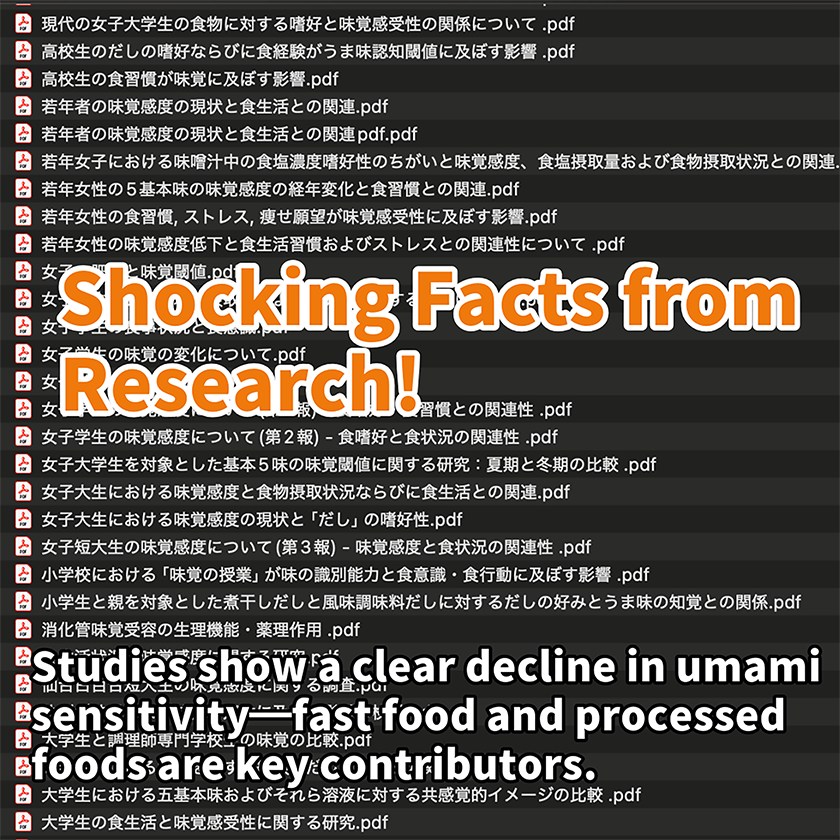
Evidence suggests a connection between young people's taste desensitization and an increasing dependence on processed, oily, and pungent-flavored foods. Processed foods have reduced the sensitivity to natural flavors.
Taste buds, which allow us to sense flavors, are most numerous during infancy and gradually decrease with age—by the age of 75, they are reduced to about half the number at birth.
Until now, taste sensitivity issues were mostly associated with the elderly.
However, studies suggest that the reasons for declining taste sensitivity among young people are as follows:
|
Generally, it is said that taste sensitivity declines with aging; however, recently, taste disorders have also been observed among young people. Although there are various causes of taste disorders, excluding those due to disease, the majority are said to result from zinc deficiency caused by dietary factors. Taste disorders in young people are considered to be related to disordered eating habits and rapid changes in living environments, such as the easy intake of preferred foods through the use of fast food, convenience stores, and prepared foods, leading to nutritional imbalances. Moreover, the excessive consumption of processed foods containing many food additives is believed to negatively affect zinc metabolism in the body. Additionally, stress in modern society may cause autonomic nervous system dysfunction, which could lead to taste disorders. From "Effects of dietary habits, stress, and drive for thinness on taste sensitivity in young Japanese women". |
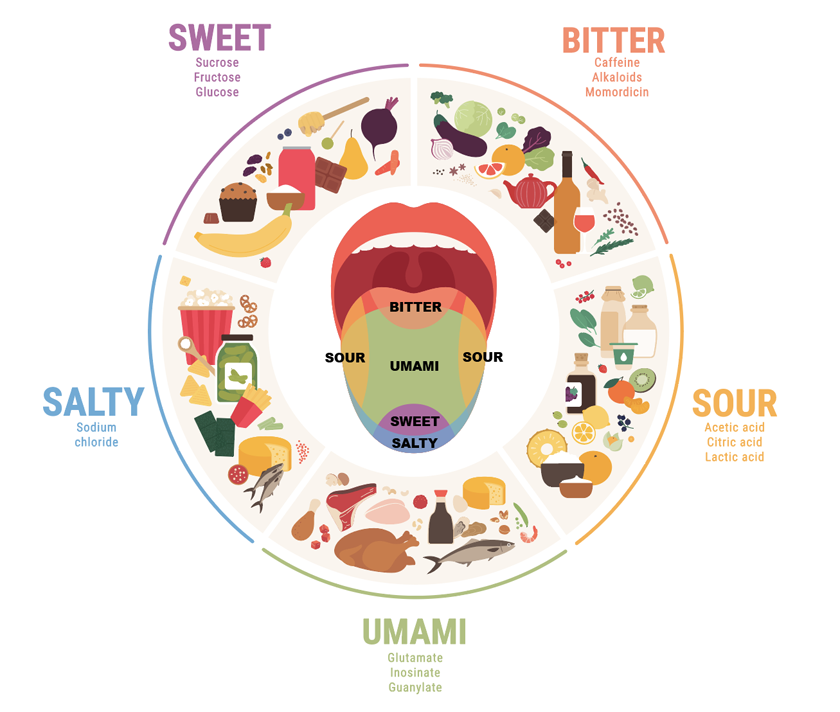
Especially, the decline in umami sensitivity is becoming more noticeable.
| Regarding the relationship with eating patterns, the group centered on ready-made meals and dining out had higher recognition thresholds for umami. It was suggested that frequent consumption of dining out, instant foods, and processed foods in daily life leads to a decline in umami sensitivity. From "Studies on sensitivity of taste and survey of eating habits". |
(Higher recognition threshold = Less sensitive, Lower threshold = More sensitive)
Among the five basic tastes — sweet, salty, sour, bitter, and umami — umami tends to have the lowest sensitivity.
Conversely, people with high umami sensitivity also tend to have sharper sensitivity to sweet and salty tastes.
| Among the taste sensitivities to the five basic tastes, the correct answer rate for umami was the lowest. An interesting result was obtained: individuals with higher umami taste sensitivity (i.e., lower threshold values) also exhibited higher sensitivity to sweet and salty tastes. From "Current Status of Taste Sensitivity and Its Relationship with Dietary Habits in Young Individuals". |
| It was inferred that individuals with high umami sensitivity have a high awareness of eating behavior, and by eating a balanced diet, their seasoning and food intake become appropriate, thereby maintaining high umami sensitivity. (omitted) Dashi contains umami components and makes it possible to enjoy delicious flavors even with light seasoning, thus contributing to salt reduction. Furthermore, it has been reported that by utilizing dashi, the tongue can be trained, allowing individuals to perceive delicate tastes, which leads to enhanced taste sensitivity. From "Taste Sensitivity, Diet Intake Frequency and Eating Habits in Female University Students" |
Supporting Studies
Even just among the studies with similar claims, we found the following:
1) "Studies on sensitivity of taste and eating behavior of university students."
4) "Studies on sensitivity of taste and survey of eating habits"
5) "Follow-up survey in taste sensitivity of five basic tastes and dietary habits of young women"
10) "Factors which relate salt intake and taste sensitivity in university female students"
11) "An Investigation on the Students' Palate Sensitivity at Sendai Shirayuri Junior College"
13) "Discriminating Ability of Mixed Taste of Junior High School Students"
14) "Discriminating Ability of Mixed Taste of Junior High School Students (2)"
15) "Taste Sensitivity, Diet Intake Frequency and Eating Habits in Female University Students"
Summary: Taste Loss Can Progress Without You Even Realizing — Start by Understanding Your Current Sensitivity.
Let's now explore what happens when umami sensitivity declines.
2. What Happens When You Lose Umami.
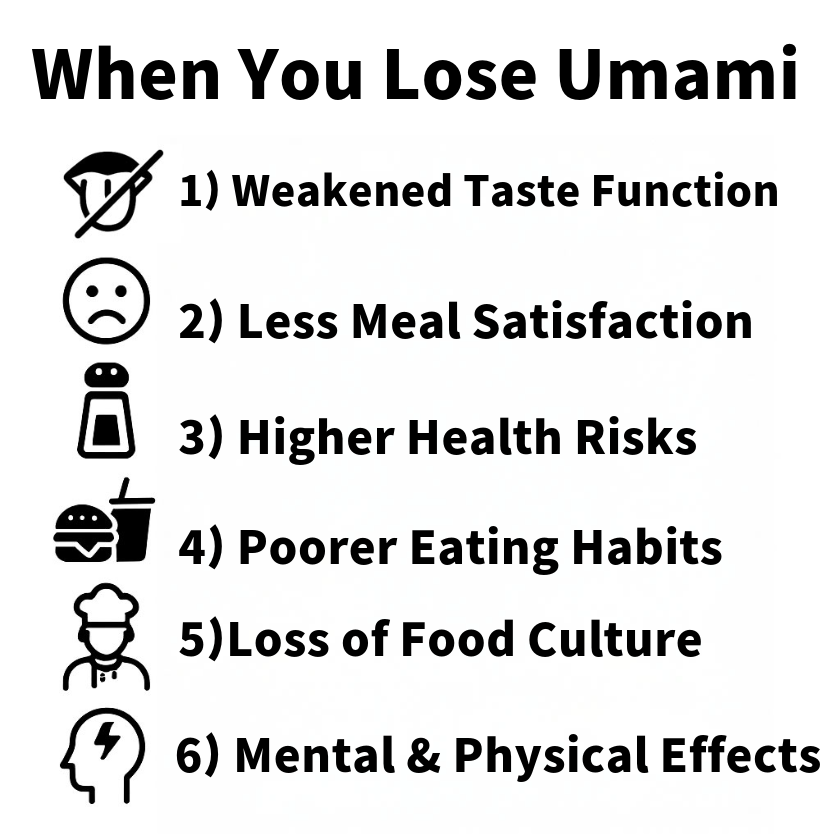
According to These Studies, Umami Desensitization May Lead to the Following Negative Effects:
-
Decreased Taste Function
When umami sensitivity is reduced, food tends to taste flat and one-dimensional, making it difficult to enjoy the original flavors of ingredients.
(Studies 1, 3, 7, 13) -
Reduced Satisfaction from Meals
The ability to enjoy eating weakens, which can negatively affect quality of life (QOL).
(Studies 1, 6) -
Increased Risk of Lifestyle Diseases
Overconsumption of salt, fat, and sugar can result, raising the risk of obesity, high blood pressure, and other lifestyle-related diseases.
(Studies 1, 3, 5, 10, 15) -
Poorer Eating Habits and Food Choices
People may become more dependent on processed or restaurant food, making it harder to build awareness of meal quality and nutritional balance.
(Studies 2, 5, 15) -
Diminished Appreciation for Traditional Japanese Food Culture
People may no longer be able to perceive the delicate umami of dashi, resulting in a loss of connection with Japanese cuisine and dashi culture.
(Studies 1, 3, 8) -
Physiological and Psychological Effects
When combined with stress or pressure to be thin, umami desensitization can worsen, potentially affecting both mental and physical health.
(Study 6)
Summary: Losing your ability to taste umami undermines the foundation of a healthy diet. Take a moment to rediscover the value of umami — the foundation of a joyful and healthy life.
3. Does Relying on Instant Dashi Dull Umami Sensitivity?
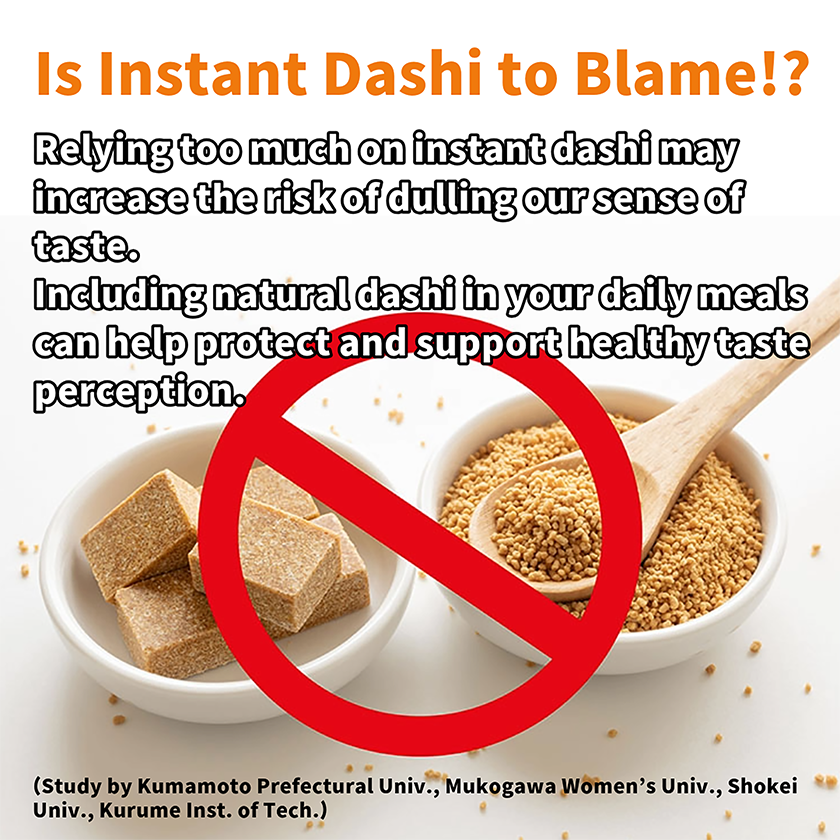
Relying on instant dashi may dull your sensitivity to authentic umami.
In the study titled “Effects of Broth Preference and Dietary Experience on Umami-Recognition Threshold of High School Students,"
the type of dashi used at home was statistically evaluated by logistic regression analysis to determine its effect on the umami recognition threshold (sensitivity to umami).
(This study surveyed 183 first-year high school students from School D in Kumamoto Prefecture.)
| Type of dashi used at home: Odds ratio 1.70, 95% confidence interval 1.136–2.533, P=0.010 (5: Not used, 4: Commercial dashi, 3: Mostly commercial dashi, 2: Mostly natural dashi, 1: Only natural dashi) |
This variable classifies what type of "dashi" was used at home into five stages and scores it.
-
Only natural dashi is used
-
Mostly natural dashi is used
-
Mostly commercial dashi is used
-
Only commercial dashi is used
-
Dashi is not used (i.e., no preparation of dashi)
In this study, "commercial dashi" refers to granulated flavor seasoning products.
An odds ratio of 1.70 means that each increase in the usage stage (e.g., from natural to commercial) increases the probability of becoming less sensitive to umami (i.e., the umami recognition threshold becoming higher) by 1.7 times.
For example, moving from Score 2 (mostly natural dashi) to Score 3 (mostly commercial dashi) increases the risk by 1.7 times.
Furthermore, moving from Score 1 (only natural dashi) to Score 4 (only commercial dashi) means increasing by three stages, so
1.7 × 1.7 × 1.7 = 4.913.
Thus, the risk of umami insensitivity (i.e., higher umami recognition threshold) increases by approximately 4.9 times.
Thus, continuing a diet that relies on commercial granulated dashi instead of using natural dashi at home could lead to an approximately 4.9 times higher risk of becoming less sensitive to umami, compared to those who use natural dashi.
This indicates that the choice of dashi at home has a significant impact on the development of children's taste sensitivity.
Meaning of "95% confidence interval 1.136 – 2.533":
This range means that "there is a 95% probability that the true odds ratio falls within this range."
Since the lower limit is greater than 1 (1.136), the difference is considered statistically significant.
Meaning of "P = 0.010":
A P-value of 0.010 means "there is only a 1% probability that this result occurred by chance."
Since it is less than the conventional threshold of P < 0.05, this factor (type of dashi used) is recognized as an important factor statistically affecting umami sensitivity.
Thus, the following points were clarified in this study:
-
The more frequently natural dashi is used at home, the higher the sensitivity to umami (i.e., the lower the umami recognition threshold), and this tendency was statistically significant.
-
Conversely, in households where dashi is not used and only commercial granulated dashi is relied upon, the risk of becoming insensitive to umami increases.
Commercially produced granulated dashi tends to always have the same taste,
whereas natural dashi exhibits slight but distinct differences in taste even when made under similar conditions with varying ingredients.
This does not mean that commercial dashi is bad.
It is understandable that many people use commercial granulated dashi because of its convenience.
In the next section, we will explain with evidence how just drinking a bowl of miso soup made with natural dashi once a day can help improve umami sensitivity.
Even small efforts to incorporate natural dashi into daily life can help preserve the taste sensitivity for the future.
According to this study, not only granulated dashi but also the following lifestyle habits, preferences, and home environments are statistically significantly associated with a decrease in umami sensitivity:
-
Relying on commercial dashi instead of using natural dashi (Odds ratio 1.70 per stage)
-
Preferring spicy or strong-tasting foods (Odds ratio 0.67)
-
Having a diet centered on fats and meat (Odds ratio 2.99)
-
Parents not favoring Japanese food (Odds ratio 1.88)
-
Insensitivity to other tastes (saltiness, sourness, bitterness) (Odds ratios: saltiness 0.25, sourness 0.31, bitterness 0.19)
[About Odds Ratios]
-
Odds ratio (OR) = 1.0: No effect (the factor neither increases nor decreases the risk)
-
Odds ratio > 1.0: The factor increases the risk
-
Odds ratio < 1.0: The factor decreases the risk (protective effect)
In other words, when the odds ratio is less than 1.0, it means that "the presence of the factor lowers the risk."
The more a person can properly perceive saltiness, sourness, and bitterness, the more sensitive they are likely to be to umami as well.
Although umami was discovered by the Japanese and is now recognized internationally as "Umami,"
looking at the factors that lower umami sensitivity described above,
it seems that individuals who do not regularly consume traditional Japanese foods may struggle to fully appreciate the umami taste.
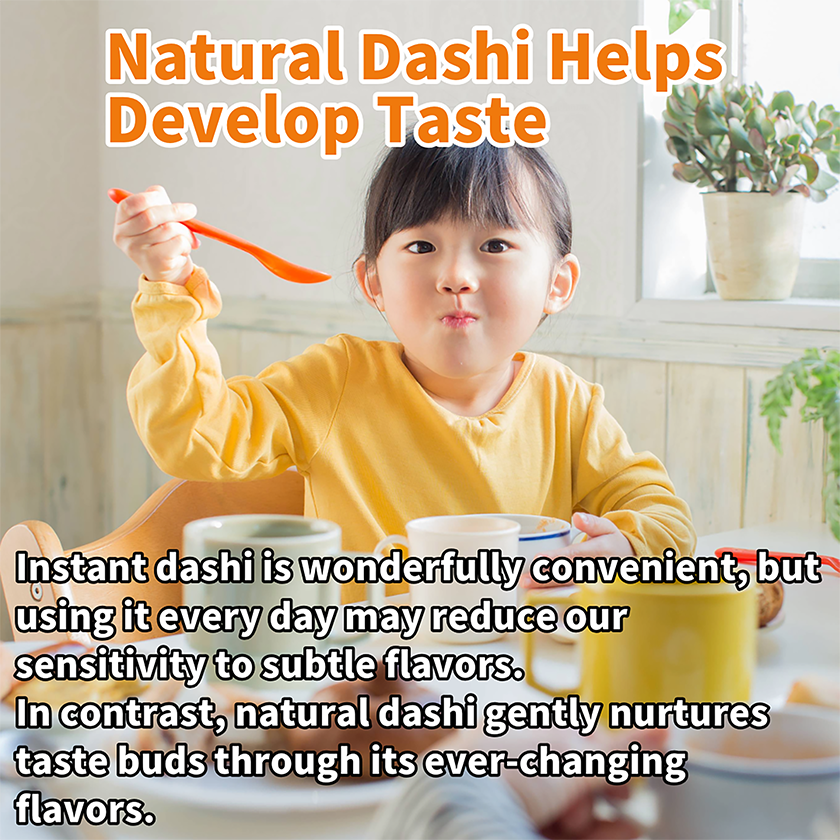
Summary: A diet centered around granulated dashi (flavor seasoning) gradually narrows the world of taste without one even realizing it.
4. Boost Your Umami Sensitivity with Natural Dashi

To enhance your ability to sense umami, it’s effective to regularly include foods made with natural dashi in your meals.
For example, simply drinking miso soup made with natural dashi every day can help sharpen your taste sensitivity over time.
Many academic papers have reported similar findings.
"In particular, a significant difference was observed in the umami threshold, with the group that drank soup seven or more times per week having a lower threshold and better sensitivity compared to the group that did not drink soup." (Study 1)
"Dashi contains umami components and enables foods to taste delicious even with light seasoning, thereby contributing to a salt-reducing effect. Furthermore, it has been reported that utilizing dashi trains the tongue, making it possible to perceive delicate flavors and leading to enhanced taste sensitivity." (Study 15)
"Unlike the other basic tastes, individuals with a higher preference for umami-rich foods tend to have higher taste sensitivity." (Study 2)
The study suggested that the experience of consuming dashi had a stronger influence on the umami recognition threshold than mere preference for dashi, as the probability of belonging to the "non-low threshold group" was significantly higher among those whose parents "did not favor Japanese cuisine" and those who used "no dashi" or "mainly commercial dashi" at home. (Study 3) (Non-low threshold group = Insensitive)
"The participants studied food and health from their first to fourth academic years, gained experience with natural broth through cooking practice, became able to recognize umami, and it is presumed that improvements in their awareness and behavior regarding health and nutrition, as well as enhancements in their taste sensitivity, are the results of these experiences." (Study 5)
"When dishes are finished using Hondashi, they tend to end up with a similar flavor overall, often compromising the original taste of the ingredients." "During this study, we heard one student remark, 'I used to think Hondashi was the most delicious, but after tasting and comparing it like this, I realized the differences, and now I feel the taste of Hondashi is rather heavy.' This confirmed the educational effect." (Study 7)
"It was suggested that experiencing 'natural dashi' during early growth stages may help establish a preference for dashi extracted from natural ingredients and enhance the ability to perceive the umami of 'natural dashi'." "Based on the results of this study, it was suggested that differences in dashi preference lead to differences in umami perception. It was considered necessary to have children experience 'natural dashi' and to provide education aimed at enhancing their recognition of the umami taste of 'natural dashi'." (Study 8)
"The group that had continuously experienced natural dashi was found to highly evaluate the taste components of the dashi and to have a stronger perception of umami." "The finding that differences in the experience of consuming 'natural dashi' and 'seasoned dashi' during childhood and adolescence influence the preference for dashi provides valuable evidence that, even in humans, the timing and type of food experiences contribute to the formation of taste preferences." (Study 9)
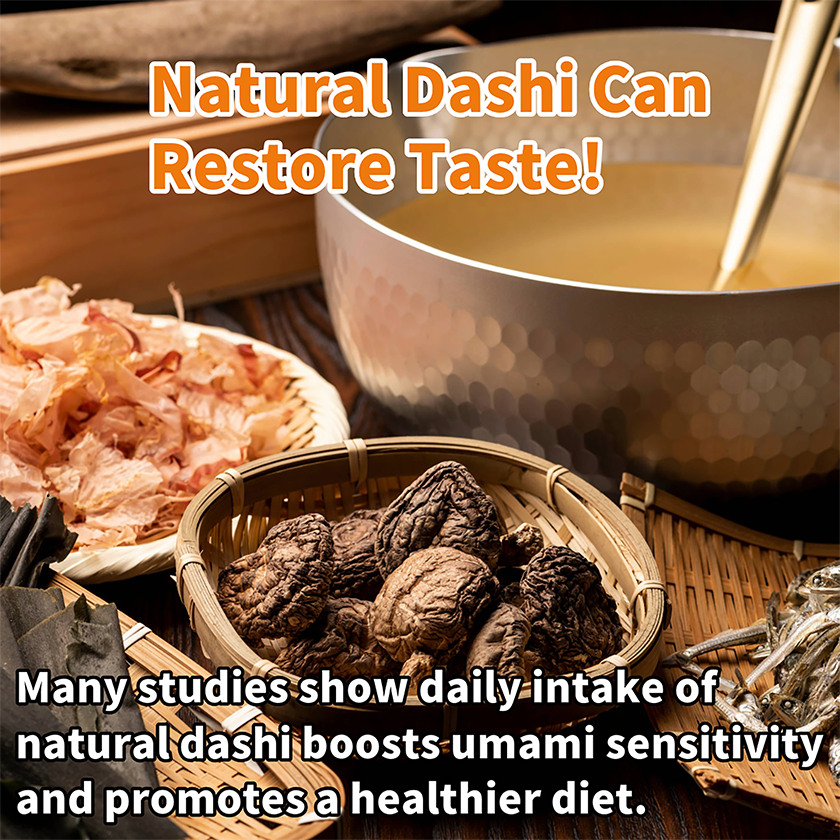
Summary: Natural Dashi Is the Best Training for Your Taste Sensitivity — Start with a Small Step.
5. What Happens in Your Body When You Drink Miso Soup
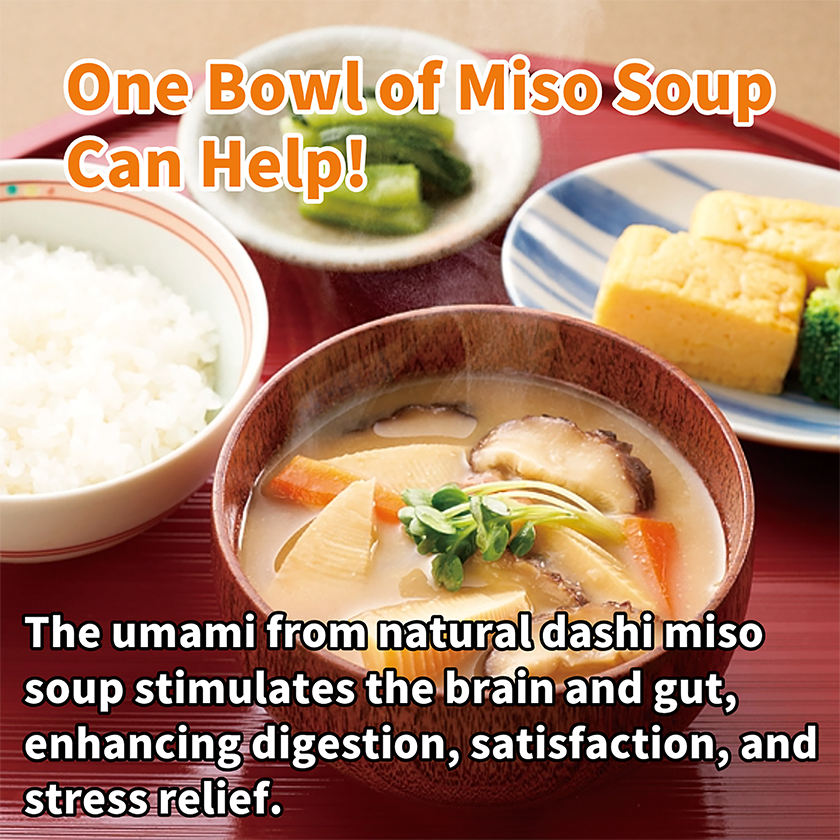
"Drinking miso soup or broth containing 'dashi' before a meal helps digestion and enhances the feeling of satiety."
This long-standing wisdom rooted in traditional food culture has been clearly and scientifically supported by neurophysiological, gastrointestinal physiological, hormonal, and clinical data presented in the paper "Umami taste : The essence of Japanese cuisine, umami is the essence to maintain healthy gut(Taste (umami) and oral health - aiming at healthy life)."
According to this paper, the following processes occur sequentially inside the body when miso soup containing dashi is consumed:
🥣 Consume dashi
⬇︎
👅 Detect umami on the tongue
⬇︎
🧠 Vagus nerve activates brain and gut
⬇︎
🛠️ Stimulate digestive secretions and hormones
⬇︎
🛡️ Secrete mucus and bicarbonate
⬇︎
🧘♂️ Send satiety signals to the brain
⬇︎
🥩 Promote protein digestion and absorption
⬇︎
❤️ Protect gut health and improve QOL
One bowl of natural dashi protects your body!
Summary: Miso soup is the ultimate ally that trains your taste buds and supports your health at the same time.
6. Natural Dashi Helps Restore Your Umami Sensitivity!

Various scientific studies have shown that drinking miso soup made with natural dashi daily can enhance your ability to taste umami flavors.
In this section, we’ll introduce tips for easily making authentic natural dashi miso soup at home.
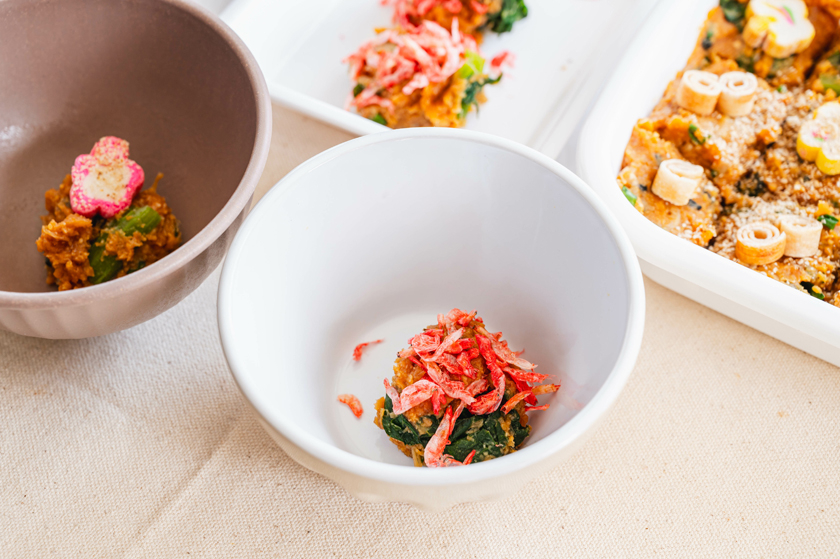 Tip 1: Make Miso Balls for Easy Miso Soup!
Tip 1: Make Miso Balls for Easy Miso Soup!
-
Finely crush the contents of a dashi pack.
-
Mix it with miso and your choice of ingredients.
-
Shape into small balls.
You can simply dissolve one in hot water whenever you want a quick bowl of miso soup.
🔎 Search for "Miso Balls" online to find plenty of recipe ideas!
Tip 2: Easy Mug Miso Soup for the Office!
Since both miso and dashi powder can be stored at room temperature, it's easy to make miso soup at work too!
-
Buy an additive-free dashi pack, and transfer the powder into a container.
-
Boost the natural umami by adding Kyushu Premium Shiitake Powder to the dashi powder.
-
At the office, prepare a tea strainer and place it into a mug.
-
Add a half teaspoon of chopped dried wakame (or adjust to taste) into the strainer.
-
Pour hot water into the mug.
-
Add about a heaping half teaspoon (2.5cc) of dashi powder for one serving.
-
After 2–3 minutes, remove the strainer and stir in a spoonful of miso with a curry spoon.
If you don’t have a measuring spoon at the office, using a standard curry spoon works fine.
A half curry spoonful of miso and wakame is roughly the perfect amount!
Miso without additives can also be stored at room temperature, making it convenient for office drawers.
Although the flavor may change slightly over time, it won’t affect the taste.
Forest-grown Shiitake Powder
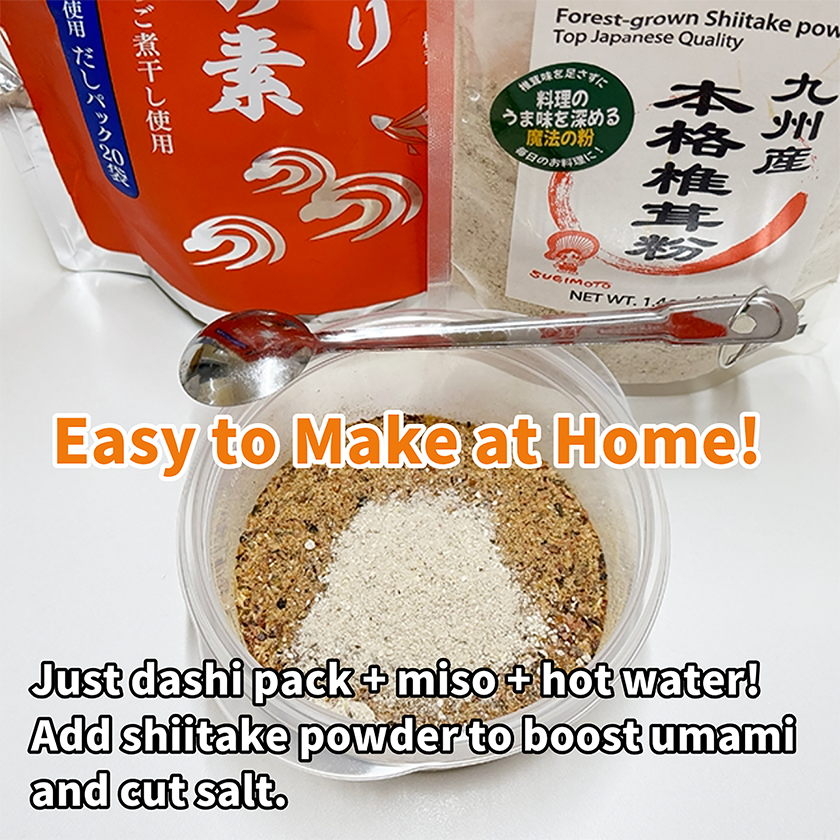
Our Premium Shiitake Powder is made from shiitake cultivated on sweet-sap oak trees (Kunugi).
It contains about six times more Glutamate—the natural umami booster—than regular shiitake.
Adding it to natural dashi miso soup not only intensifies the broth, but also enriches the miso's flavor.
Because the umami and saltiness feel stronger, you can naturally reduce the amount of miso you use.
(If you're using ready-made dashi packs that already contain shiitake, try adding this Shiitake powder about 1/8 of the total amount of dashi for even better flavor!)
Our Premium Shiitake Powder doesn’t just make dishes tastier—it's also rich in vitamin D and beta-glucans.
If you’d like to learn more about how to make traditional Japanese dashi, we highly recommend this in-depth guide by Just One Cookbook:
👉 How to Make Dashi (The Ultimate Guide)
It’s a clear and beautifully photographed introduction to the various types of dashi and how to prepare them at home.
Where to buy our Shiitake

 E-commerce site E-commerce site |


